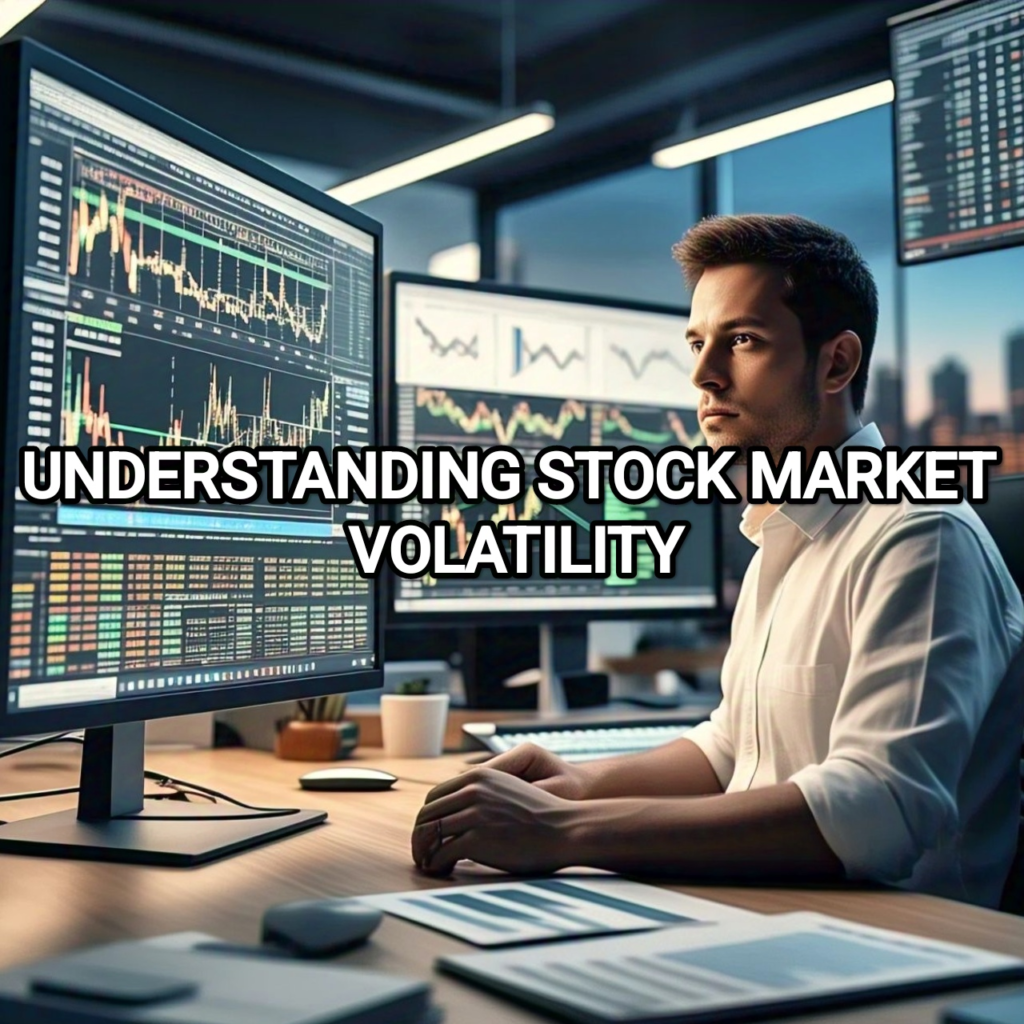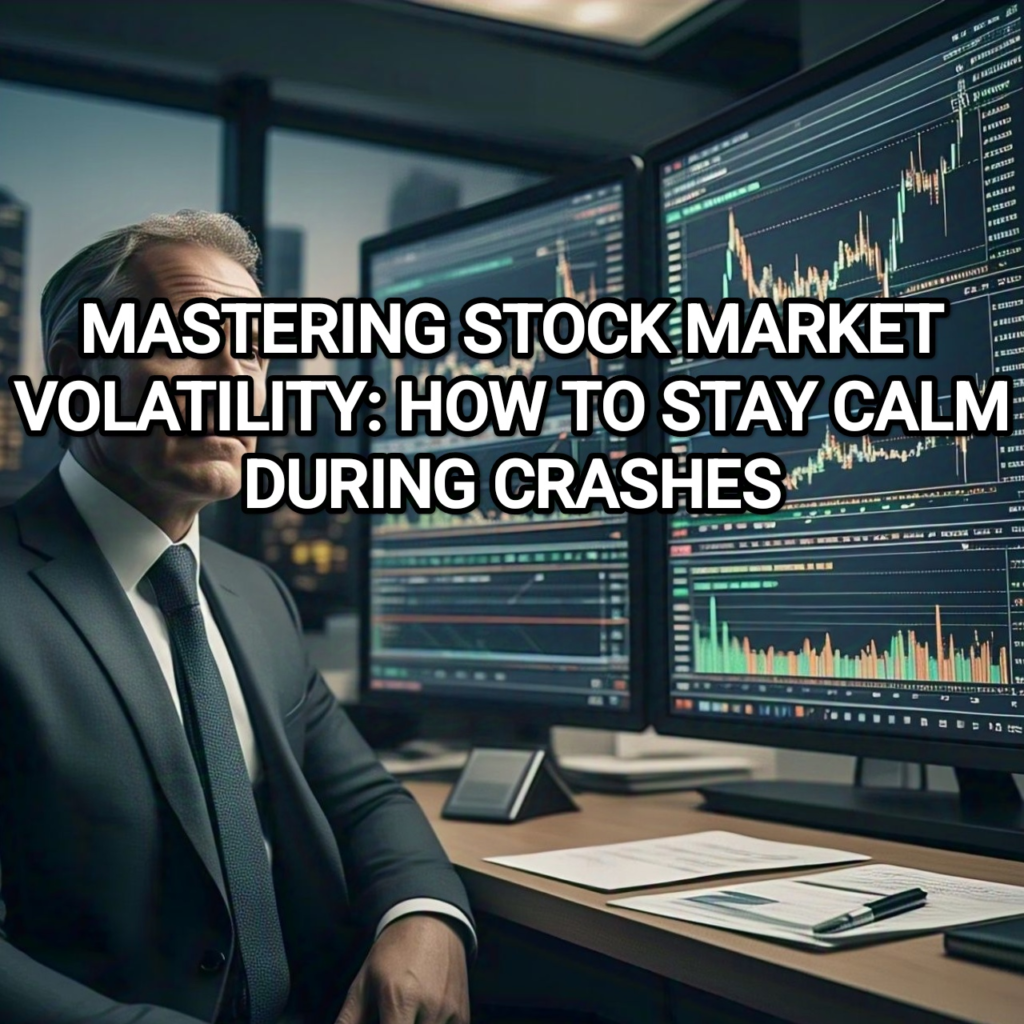MASTERING STOCK MARKET VOLATILITY: 5 PROVEN STRATEGIES TO STAY CALM DURING CRASHES
INTRODUCTION
Mastering stock market volatility: Learn effective strategies to stay calm during market crashes. Discover tips for managing risk, maintaining a resilient mindset, and navigating turbulent market conditions. Stock market volatility can be nerve-wracking, especially during crashes. Investors often find themselves in a panic, making rash decisions that lead to losses. Understanding how to manage emotions, make strategic investment choices, and leverage expert financial advice is crucial for long-term success. Whether you are a seasoned investor or a beginner, mastering stock market volatility will help you safeguard your investments and capitalize on opportunities.
UNDERSTANDING STOCK MARKET VOLATILITY

Stock market volatility refers to the frequent and significant price fluctuations in the stock market. It is influenced by various factors such as economic data, geopolitical events, corporate earnings, and investor sentiment.
DEFINITION OF VOLATILITY
Volatility refers to the degree of uncertainty or risk associated with the size of changes in the value of a financial instrument, such as a stock, bond, or commodity. In the context of the stock market, volatility measures the rate at which the price of a security fluctuates.
TYPES OF VOLATILITY
1. Historical Volatility
Historical volatility measures the past fluctuations in the price of a security over a specific period. It is calculated using historical price data and is often used as a benchmark to estimate future volatility.
In Canada, historical volatility is an important metric for investors to consider, as it can provide insight into the potential risks and returns associated with a particular investment. For example, if a stock has historically been highly volatile, investors may expect higher returns to compensate for the increased risk.
Historical volatility can be calculated using various methods, including:
– Standard Deviation: This is a widely used measure of historical volatility that calculates the dispersion of returns around the mean return.
– Variance: This measures the average of the squared differences from the mean return.
– Range-Based Volatility: This measures the difference between the high and low prices of a security over a specific period.
By analyzing historical volatility, investors can gain a better understanding of the potential risks and returns associated with a particular investment and make more informed decisions.
2. Volatility
Implied volatility measures the market’s expectation of future fluctuations in the price of a security, based on option prices. It is a forward-looking measure that reflects market sentiment and is often used to estimate future volatility.
In Canada, implied volatility is an important metric for investors to consider, as it can provide insight into market expectations and potential risks. For example, if implied volatility is high, it may indicate that investors expect increased price fluctuations in the future.
Implied volatility can be calculated using various methods, including:
– Black-Scholes Model: This is a widely used model for calculating implied volatility that takes into account factors such as the underlying asset price, strike price, time to expiration, and risk-free interest rate.
– Binomial Model: This is a more complex model that uses a binomial distribution to calculate implied volatility.
By analyzing implied volatility, investors can gain a better understanding of market expectations and potential risks and make more informed decisions.
3. Realized Volatility
Realized volatility measures the actual fluctuations in the price of a security over a specific period. It is a measure of the actual volatility experienced by investors and is often used to evaluate the effectiveness of volatility forecasting models.
In Canada, realized volatility is an important metric for investors to consider, as it can provide insight into the actual risks and returns associated with a particular investment. For example, if realized volatility is high, it may indicate that investors have experienced significant price fluctuations in the past.
Realized volatility can be calculated using various methods, including:
– Historical Volatility: This is a widely used measure of realized volatility that calculates the dispersion of returns around the mean return.
– Range-Based Volatility: This measures the difference between the high and low prices of a security over a specific period.
By analyzing realized volatility, investors can gain a better understanding of the actual risks and returns associated with a particular investment and make more informed decisions.
4. Systematic Volatility
Systematic volatility, also known as beta, measures the systematic risk or volatility of a security relative to the overall market. It is a measure of how much a security’s price movements are correlated with the broader market.
In Canada, systematic volatility is an important metric for investors to consider, as it can provide insight into the potential risks and returns associated with a particular investment. For example, if a stock has a high beta, it may indicate that the stock is more volatile than the broader market.
Systematic volatility can be calculated using various methods, including:
– Beta: This is a widely used measure of systematic volatility that calculates the correlation between a security’s returns and the broader market returns.
– Capital Asset Pricing Model (CAPM): This is a model that calculates the expected return of a security based on its beta and the expected return of the broader market.
By analyzing systematic volatility, investors can gain a better understanding of the potential risks and returns associated with a particular investment and make more informed decisions.
5. Idiosyncratic Volatility
Idiosyncratic volatility measures the unique risk or volatility of a security that is not explained by the broader market. It is a measure of how much a security’s price movements are driven by company-specific factors rather than market-wide factors.
In Canada, idiosyncratic volatility is an important metric for investors to consider, as it can provide insight into the potential risks and returns associated with a particular investment. For example, if a stock has high idiosyncratic volatility, it may indicate that the stock is more susceptible to company-specific risks.
Idiosyncratic volatility can be calculated using various methods, including:
– Residual Volatility: This is a widely used measure of idiosyncratic volatility that calculates the residual volatility of a security after controlling for systematic volatility.
– Fama-French Model: This is a model that calculates the expected return of a security.
FACTORS THAT INFLUENCE VOLATILITY

1. Economic Indicators
Economic indicators, such as GDP growth, inflation rates, and employment numbers, can have a significant impact on volatility in the Canadian stock market. For example:
– GDP Growth: A strong GDP growth rate can lead to increased investor confidence and lower volatility, as investors become more optimistic about the future prospects of the economy. On the other hand, a slow GDP growth rate can lead to decreased investor confidence and higher volatility.
– Inflation Rates: High inflation rates can lead to higher volatility, as investors become concerned about the impact of inflation on asset values. Low inflation rates, on the other hand, can lead to lower volatility.
– Employment Numbers: Strong employment numbers can lead to increased investor confidence and lower volatility, as investors become more optimistic about the future prospects of the economy. Weak employment numbers, on the other hand, can lead to decreased investor confidence and higher volatility.
In Canada, economic indicators are closely watched by investors and can have a significant impact on volatility. For example, the Bank of Canada’s interest rate decisions are closely watched by investors and can impact volatility.
2. Global Events
Global events, such as geopolitical tensions, natural disasters, and pandemics, can have a significant impact on volatility in the Canadian stock market. For example:
– Geopolitical Tensions: Increased geopolitical tensions, such as trade wars or military conflicts, can lead to higher volatility, as investors become concerned about the impact of these events on global trade and economic growth.
– Natural Disasters: Natural disasters, such as hurricanes or wildfires, can lead to higher volatility, as investors become concerned about the impact of these events on economic growth and asset values.
– Pandemics: Pandemics, such as COVID-19, can lead to higher volatility, as investors become concerned about the impact of these events on global economic growth and asset values.
In Canada, global events can have a significant impact on volatility, particularly if they impact global trade or economic growth.
3. Company Performance
Company performance, such as earnings reports and revenue growth, can have a significant impact on volatility in the Canadian stock market. For example:
– Earnings Reports: Strong earnings reports can lead to increased investor confidence and lower volatility, as investors become more optimistic about the future prospects of the company. Weak earnings reports, on the other hand, can lead to decreased investor confidence and higher volatility.
– Revenue Growth: Strong revenue growth can lead to increased investor confidence and lower volatility, as investors become more optimistic about the future prospects of the company. Weak revenue growth, on the other hand, can lead to decreased investor confidence and higher volatility.
In Canada, company performance is closely watched by investors and can have a significant impact on volatility.
4. Investor Sentiment
Investor sentiment, such as shifts in risk appetite or market expectations, can have a significant impact on volatility in the Canadian stock market. For example:
– Risk Appetite: Increased risk appetite among investors can lead to higher volatility, as investors become more willing to take on risk and invest in riskier assets. Decreased risk appetite, on the other hand, can lead to lower volatility.
– Market Expectations: Changes in market expectations, such as shifts in interest rate expectations or economic growth expectations, can lead to higher volatility, as investors adjust their portfolios to reflect the new expectations.
In Canada, investor sentiment is closely watched by investors and can have a significant impact on volatility.
5. Market Liquidity
Market liquidity, such as trading volume and market depth, can have a significant impact on volatility in the Canadian stock market. For example:
– Trading Volume: High trading volume can lead to lower volatility, as there are more buyers and sellers in the market, which can help to stabilize prices. Low trading volume, on the other hand, can lead to higher volatility.
– Market Depth: High market depth can lead to lower volatility, as there are more buyers and sellers at different price levels, which can help to stabilize prices. Low market depth, on the other hand, can lead to higher volatility.
In Canada, market liquidity is closely watched by investors and can have a significant impact on volatility.
6. Regulatory Changes
Regulatory changes, such as changes to tax laws or financial regulations, can have a significant impact on volatility in the Canadian stock market. For example:
– Tax Laws: Changes to tax laws, such as changes to capital gains tax rates, can impact volatility, as investors adjust their portfolios to reflect the new tax laws.
– Financial Regulations: Changes to financial regulations, such as changes to banking regulations or securities laws, can impact volatility, as investors adjust their portfolios to reflect the new regulations.
In Canada, regulatory changes are closely watched by investors and can have a significant impact on volatility.
7. Natural Disasters
Natural disasters, such as hurricanes, wildfires, or floods, can have a significant impact on volatility in the Canadian stock market. For example:
– Hurricanes: Hurricanes can impact volatility, as investors become concerned about the impact of the storm on businesses and infrastructure in the affected areas.
– Wildfires: Wildfires can impact volatility, as investors become concerned about the impact of the fires on businesses and infrastructure in the affected areas.
– Floods: Floods can impact volatility, as investors become concerned about the impact of the floods on businesses and infrastructure in the affected areas.
In Canada, natural disasters can have a significant impact on volatility, particularly if they impact key industries such as energy, agriculture, or forestry.
8. Geopolitical Tensions
Geopolitical tensions, such as trade wars, military conflicts, or diplomatic crises, can have a significant impact on volatility in the Canadian stock market. For example:
– Trade Wars: Trade wars between Canada and other countries, such as the United States or China, can impact volatility, as investors become concerned about the impact of tariffs and trade restrictions on Canadian businesses.
– Military Conflicts: Military conflicts, such as the conflict in Ukraine, can impact volatility, as investors become concerned about the impact of conflict on global economic growth and stability.
– Diplomatic Crises: Diplomatic crises, such as the crisis between Canada and Saudi Arabia, can impact volatility, as investors become concerned about the impact of diplomatic tensions on Canadian businesses and trade.
9. Central Bank Actions
Central bank actions, such as interest rate decisions or quantitative easing, can have a significant impact on volatility in the Canadian stock market. For example:
– Interest Rate Decisions: Interest rate decisions by the Bank of Canada can impact volatility, as investors adjust their expectations for future interest rates and economic growth.
– Quantitative Easing: Quantitative easing by the Bank of Canada can impact volatility, as investors adjust their expectations for future economic growth and inflation.
10. Market Sentiment
Market sentiment, such as shifts in investor attitudes or market expectations, can have a significant impact on volatility in the Canadian stock market. For example:
– Investor Attitudes: Shifts in investor attitudes, such as increased risk appetite or decreased risk tolerance, can impact volatility, as investors adjust their portfolios to reflect their changing attitudes.
– Market Expectations: Shifts in market expectations, such as changes in expectations for future economic growth or interest rates, can impact volatility, as investors adjust their portfolios to reflect the new expectations.
11. Technical Analysis
Technical analysis, such as trends, chart patterns, and momentum indicators, can have a significant impact on volatility in the Canadian stock market. For example:
– Trends: Trends, such as uptrends or downtrends, can impact volatility, as investors adjust their portfolios to reflect the trend.
– Chart Patterns: Chart patterns, such as head and shoulders or inverse head and shoulders, can impact volatility, as investors adjust their portfolios to reflect the pattern.
– Momentum Indicators: Momentum indicators, such as relative strength index (RSI) or moving average convergence divergence (MACD), can impact volatility, as investors adjust their portfolios to reflect the momentum.
12. Seasonality
Seasonality, such as seasonal fluctuations in demand or supply, can have a significant impact on volatility in the Canadian stock market. For example:
Seasonal Fluctuations: Seasonal fluctuations in demand or supply, such as increased demand for winter clothing or decreased demand for summer vacations, can impact volatility, as investors adjust their portfolios to reflect the seasonal fluctuations.
13. Earnings Season
Earnings season, which typically occurs quarterly, can have a significant impact on volatility in the Canadian stock market. For example:
– Earnings Reports: Earnings reports can impact volatility, as investors adjust their expectations for future earnings and revenue growth.
– Revenue Growth: Revenue growth can impact volatility, as investors adjust their expectations for future revenue growth and profitability.
14. Mergers and Acquisitions
Mergers and acquisitions can have a significant impact on volatility in the Canadian stock market. For example:
– Merger Announcements: Merger announcements can impact volatility, as investors adjust their expectations for future earnings and revenue growth.
– Acquisition Activity: Acquisition activity can impact volatility, as investors adjust their expectations for future earnings and revenue growth.
15. Economic Indicators
Economic indicators, such as GDP growth, inflation rates, and employment numbers, can have a significant impact on volatility in the Canadian stock market. For example:
– GDP Growth: GDP growth can impact volatility, as investors adjust their expectations for future economic growth and interest rates.
– Inflation Rates: Inflation rates can impact volatility, as investors adjust their expectations for future inflation and interest rates.
– Employment Numbers: Employment numbers can impact volatility, as investors adjust their expectations for future
CAUSES OF MARKET VOLATILITY

1. Economic Indicators: GDP growth, inflation rates, and employment data influence investor confidence.
2. Political and Geopolitical Events: Elections, trade wars, and global conflicts can cause uncertainty.
3. Interest Rate Changes: Central bank policies impact borrowing costs and market liquidity.
4. Corporate Performance: Earnings reports and financial health of companies drive stock prices.
5. Market Speculation: High-frequency trading and speculative investments contribute to price swings.
HOW TO STAY CALM DURING MARKET CRASHES

1. Develop a Long-Term Investment Strategy
A well-structured investment plan is essential to navigate market volatility. Define your financial goals, risk tolerance, and asset allocation strategy.
2. Diversify Your Investment Portfolio
Diversification minimizes risks by spreading investments across various asset classes, such as stocks, bonds, real estate, and commodities. It reduces the impact of a single market downturn.
3. Avoid Panic Selling
Emotional reactions can lead to impulsive decisions. Historical data shows that markets recover over time. Selling in panic often locks in losses, whereas holding steady allows for potential recovery.
4. Focus on Fundamental Analysis
Rather than reacting to short-term market noise, assess a company’s long-term value through revenue growth, earnings reports, and competitive positioning.
5. Consult a Financial Advisor
Seeking professional guidance from a financial advisor in Ontario or a Canada tax expert can help tailor investment strategies that align with your financial goals and tax obligations.
THE IMPACT OF VOLATILITY ON INVESTORS

Stock market volatility can have a profound impact on investors, particularly those who are new to the game or haven’t developed a robust investment strategy. Some common pain points associated with volatility include:
1. Emotional decision-making: Investors may be tempted to make impulsive decisions based on fear or greed, rather than sticking to a well-thought-out investment plan.
2. Portfolio losses: Volatility can result in significant losses, especially if investors are over-exposed to a particular asset class or sector.
3. Lack of confidence: Repeated exposure to market fluctuations can erode investor confidence, leading to a decrease in investment activity or even a complete withdrawal from the market.
MASTERING STOCK MARKET VOLATILITY: STRATEGIES FOR SUCCESS

So, how can you stay calm and composed during market crashes? Here are some practical strategies to help you master stock market volatility:
1. Diversification: Spread your investments across a range of asset classes, sectors, and geographies to minimize exposure to any one particular market or sector.
2. Dollar-cost averaging: Invest a fixed amount of money at regular intervals, regardless of market conditions, to reduce the impact of volatility on your portfolio.
3. Long-term perspective: Focus on your long-term investment goals, rather than getting caught up in short-term market fluctuations.
4. Risk management: Implement risk management strategies, such as stop-loss orders or options hedging, to limit potential losses.
5. Regular portfolio rebalancing: Periodically review and adjust your portfolio to ensure it remains aligned with your investment objectives and risk tolerance.
CANADA TAX EXPERT INSIGHTS: TAX-EFFICIENT INVESTING
As a Canada tax expert, it’s essential to consider the tax implications of your investment decisions. Here are some tax-efficient investing strategies to help you minimize tax liabilities:
1. Tax-loss harvesting: Offset capital gains by selling securities that have declined in value, and use the losses to reduce your tax liability.
2. Tax-deferred investing: Utilize tax-deferred accounts, such as Registered Retirement Savings Plans (RRSPs) or Tax-Free Savings Accounts (TFSAs), to minimize tax liabilities.
3. Dividend investing: Invest in dividend-paying stocks, which can provide a relatively stable source of income and potentially lower tax liabilities.
FREQUENTLY ASKED QUESTIONS
Q1: What is stock market volatility, and why is it important?
A1: Stock market volatility refers to the fluctuations in the value of stocks and other securities. It’s essential to understand volatility because it can impact investment returns and risk levels.
Q2: How can I protect my portfolio during a market crash?
A2: There are several strategies to protect your portfolio during a market crash, including diversification, dollar-cost averaging, and hedging. It’s also essential to have a well-thought-out investment plan and to avoid making impulsive decisions based on emotions.
Q3: What are some common mistakes investors make during periods of high volatility?
A3: Some common mistakes investors make during periods of high volatility include selling low and buying high, over-reacting to market fluctuations, and failing to diversify their portfolios.
Q4: How can I stay calm during a market crash?
A4: To stay calm during a market crash, it’s essential to have a well-thought-out investment plan, to focus on the long-term, and to avoid making impulsive decisions based on emotions. It’s also helpful to take a break from watching the markets and to focus on other aspects of your life.
Q5: What are some strategies for managing risk during periods of high volatility?
A5: Some strategies for managing risk during periods of high volatility include diversification, hedging, and dollar-cost averaging. It’s also essential to have a well-thought-out investment plan and to avoid taking on too much risk.
Q6: How can I use technical analysis to navigate volatile markets?
A6: Technical analysis can be used to identify trends, patterns, and levels of support and resistance. By using technical analysis, investors can gain insights into market sentiment and make more informed investment decisions.
Q7: What are some common indicators of market volatility?
A7: Some common indicators of market volatility include the VIX index, the CBOE Volatility Index, and the S&P 500 index. These indicators can provide insights into market sentiment and help investors anticipate potential volatility.
Q8: How can I use options to manage risk during periods of high volatility?
A8: Options can be used to hedge against potential losses or to speculate on potential gains. By using options, investors can manage risk and potentially profit from volatility.
Q9: What are some strategies for investing in volatile markets?
A9: Some strategies for investing in volatile markets include dollar-cost averaging, diversification, and hedging. It’s also essential to have a well-thought-out investment plan and to avoid making impulsive decisions based on emotions.
Q10: How can I stay informed about market developments during periods of high volatility?
A10: To stay informed about market developments during periods of high volatility, it’s essential to follow reputable financial news sources, to monitor market indicators, and to stay up-to-date with economic data and trends.
Q11: What are some common mistakes investors make when trying to time the market?
A11: Some common mistakes investors make when trying to time the market include trying to predict market tops and bottoms, over-reacting to market fluctuations, and failing to diversify their portfolios.
Q12: How can I use dividend investing to reduce volatility in my portfolio?
A12: Dividend investing can help reduce volatility in a portfolio by providing a relatively stable source of income. By investing in dividend-paying stocks, investors can potentially reduce their exposure to market fluctuations.
Q13: What are some strategies for managing emotions during periods of high volatility?
A13: Some strategies for managing emotions during periods of high volatility include taking a break from watching the markets, focusing on the long-term, and avoiding impulsive decisions based on emotions.
Q14: How can I use tax-loss harvesting to reduce volatility in my portfolio?
A14: Tax-loss harvesting involves selling securities that have declined in value to realize losses, which can be used to offset gains from other securities. By using tax-loss harvesting, investors can potentially reduce their tax liability and volatility in their portfolio.
Q15: What are some common indicators of a market bottom?
A15: Some common indicators of a market bottom include oversold conditions, bullish divergences, and increased buying activity. However, it’s essential to remember that no indicator is foolproof, and market bottoms can be difficult to predict.
THINGS TO AVOID

1. Panic Selling
Panic selling is one of the most common mistakes investors make during periods of high volatility. When the market starts to decline, many investors panic and sell their stocks, hoping to avoid further losses. However, this strategy often backfires, as investors end up selling low and missing out on potential gains when the market recovers.
To avoid panic selling, it’s essential to have a well-thought-out investment plan and to stick to it, even during periods of high volatility. This means setting clear investment goals, assessing your risk tolerance, and diversifying your portfolio to minimize risk.
2. Emotional Decision-Making
Emotional decision-making is another common mistake investors make during periods of high volatility. When the market is fluctuating wildly, it’s easy to get caught up in the emotions of the moment and make impulsive decisions based on fear or greed.
To avoid emotional decision-making, it’s essential to take a step back and assess the situation objectively. This means focusing on the fundamentals of the companies you’re invested in, rather than getting caught up in short-term market fluctuations.
3. Over-Reaction
Over-reaction is another common mistake investors make during periods of high volatility. When the market starts to decline, many investors over-react by selling too many stocks or investing too heavily in safe-haven assets.
To avoid over-reaction, it’s essential to keep things in perspective and focus on the long-term. This means avoiding the temptation to make drastic changes to your portfolio based on short-term market fluctuations.
4. Lack of Diversification
Lack of diversification is another common mistake investors make during periods of high volatility. When the market starts to decline, investors who have too much of their portfolio invested in a single stock or sector can be particularly vulnerable to losses.
To avoid lack of diversification, it’s essential to spread your investments across a range of asset classes, sectors, and geographies. This can help minimize risk and reduce the impact of market fluctuations on your portfolio.
5. Failure to Set Clear Goals
Failure to set clear goals is another common mistake investors make during periods of high volatility. When the market starts to decline, investors who don’t have clear goals can be particularly vulnerable to making impulsive decisions based on emotions rather than logic.
To avoid failure to set clear goals, it’s essential to define your investment objectives, risk tolerance, and time horizon. This can help guide your investment decisions and ensure that you’re making progress towards your goals.
6. Not Having a Long-Term Perspective
Not having a long-term perspective is another common mistake investors make during periods of high volatility. When the market starts to decline, investors who focus too much on short-term market fluctuations can be particularly vulnerable to making impulsive decisions based on emotions rather than logic.
To avoid not having a long-term perspective, it’s essential to focus on the long-term and avoid getting caught up in short-term market fluctuations. This means setting clear investment goals and sticking to them, even during periods of high volatility.
7.Not Monitoring and Adjusting Your Portfolio
Not monitoring and adjusting your portfolio is another common mistake investors make during periods of high volatility. When the market starts to decline, investors who fail to monitor and adjust their portfolios can be particularly vulnerable to losses.
To avoid not monitoring and adjusting your portfolio, it’s essential to regularly review your portfolio to ensure that it remains aligned with your investment objectives and risk tolerance. This can help you identify potential areas of risk and make adjustments as needed.
8. Chasing Past Performance
Chasing past performance is another common mistake investors make during periods of high volatility. When the market starts to decline, investors who chase past performance can be particularly vulnerable to losses.
To avoid chasing past performance, it’s essential to focus on the fundamentals of the companies you’re invested in, rather than getting caught up in short-term market fluctuations. This means doing your research, setting clear investment goals, and sticking to them, even during periods of high volatility.
9. Not Considering Fees and Expenses
Not considering fees and expenses is another common mistake investors make during periods of high volatility. When the market starts to decline, investors who fail to consider fees and expenses can be particularly vulnerable to losses.
To avoid not considering fees and expenses, it’s essential to carefully evaluate the fees and expenses associated with each investment. This can help you identify potential areas of risk and make adjustments as needed.
10. Not Seeking Professional Advice
Not seeking professional advice is another common mistake investors make during periods of high volatility. When the market starts to decline, investors who fail to seek professional advice can be particularly vulnerable to losses.
To avoid not seeking professional advice, it’s essential to consider consulting with a financial advisor or investment professional. They can help you develop a personalized investment plan, provide guidance on investment decisions, and help you navigate complex market conditions.
11. Over-Leveraging
Over-leveraging is another common mistake investors make during periods of high volatility. When the market starts to decline, investors who have over-leveraged their portfolios can be particularly vulnerable to losses.
To avoid over-leveraging, it’s essential to use debt and margin responsibly. This means setting clear limits on the amount of debt you’re willing to take on and avoiding the temptation to use excessive leverage to amplify your returns.
12. Not Staying Informed
Not staying informed is another common mistake investors make during periods of high volatility. When the market starts to decline, investors who are not informed about market developments and economic trends can be particularly vulnerable to losses.
To avoid not staying informed, it’s essential to regularly follow reputable financial news sources and stay up-to-date with market analysis and research. This can help you identify potential areas of risk and make adjustments as needed.
13. Not Having a Risk Management Plan
Not having a risk management plan is another common mistake investors make during periods of high volatility. When the market starts to decline, investors who do not have a risk management plan in place can be particularly vulnerable to losses.
To avoid not having a risk management plan, it’s essential to develop a plan that outlines your risk tolerance, investment objectives, and strategies for managing risk. This can help you identify potential areas of risk and make adjustments as needed.
14. Not Being Patient
Not being patient is another common mistake investors make during periods of high volatility. When the market starts to decline, investors who are not patient can be particularly vulnerable to losses.
To avoid not being patient, it’s essential to focus on the long-term and avoid getting caught up in short-term market fluctuations. This means setting clear investment goals and sticking to them, even during periods of high volatility.
15. Not Learning from Mistakes
Not learning from mistakes is another common mistake investors make during periods of high volatility. When the market starts to decline, investors who do not learn from their mistakes can be particularly vulnerable to losses.
To avoid not learning from mistakes, it’s essential to reflect on past mistakes and use them as an opportunity to learn and improve your investment strategy. This can help you identify potential areas of risk and make adjustments as needed.
16. Over-Reacting to News Headlines
Over-reacting to news headlines is another common mistake investors make during periods of high volatility. When the market starts to decline, investors who over-react to news headlines can be particularly vulnerable to losses.
To avoid over-reacting to news headlines, it’s essential to take a step back and assess the situation objectively. This means focusing on the fundamentals of the companies you’re invested in, rather than getting caught up in short-term market fluctuations.
17. Not Considering Alternative Investments
Not considering alternative investments is another common mistake investors make during periods of high volatility. When the market starts to decline, investors who do not consider alternative investments can be particularly vulnerable to losses.
To avoid not considering alternative investments, it’s essential to evaluate the potential benefits and risks of alternative investments, such as real estate, commodities, or cryptocurrencies. This can help you identify potential areas of risk and make adjustments as needed.
18. Not Having a Tax-Efficient Investment Strategy
Not having a tax-efficient investment strategy is another common mistake investors make during periods of high volatility. When the market starts to decline, investors who do not have a tax-efficient investment strategy can be particularly vulnerable to losses.
To avoid not having a tax-efficient investment strategy, it’s essential to evaluate the tax implications of your investments and develop a strategy that minimizes tax liabilities. This can help you identify potential areas of risk and make adjustments as needed.
19. Not Considering Inflation Risks
Not considering inflation risks is another common mistake investors make during periods of high volatility. When the market starts to decline, investors who do not consider inflation risks can be particularly vulnerable to losses.
To avoid not considering inflation risks, it’s essential to evaluate the potential impact of inflation on your investments and develop a strategy that takes into account inflation risks. This can help you identify potential areas of risk and make adjustments as needed.
20. Not Having a Plan for Retirement
Not having a plan for retirement is another common mistake investors make during periods of high volatility. When the market starts to decline, investors who do not have a plan for retirement can be particularly vulnerable to losses.
To avoid not having a plan for retirement, it’s essential to develop a comprehensive retirement plan that takes into account your investment goals, risk tolerance, and time horizon. This can help you identify potential areas of risk and make adjustments as needed.
CONCLUSION
In conclusion, mastering stock market volatility requires a combination of knowledge, skills, and emotional discipline. By understanding the factors that contribute to market volatility, investors can better navigate the markets and make more informed investment decisions.
To stay calm during crashes, investors should:
1. Develop a well-thought-out investment plan: This plan should take into account your investment goals, risk tolerance, and time horizon.
2. Diversify your portfolio: Spread your investments across different asset classes, sectors, and geographies to minimize risk.
3. Focus on the long-term: Avoid getting caught up in short-term market fluctuations and focus on your long-term investment goals.
4. Stay informed but avoid emotional decision-making: Stay up-to-date with market developments and economic trends, but avoid making impulsive decisions based on emotions.
5. Have a risk management plan: Develop a plan that outlines your risk tolerance, investment objectives, and strategies for managing risk.
6. Avoid over-leveraging: Use debt and margin responsibly and avoid excessive leverage.
7. Stay calm and patient: Avoid making impulsive decisions based on emotions and focus on your long-term investment goals.
By following these strategies, investors can better navigate the markets and stay calm during crashes. Remember, investing in the stock market involves risk, but with a well-thought-out investment plan and emotional discipline, you can achieve your long-term investment goals.
KEY TAKEAWAYS:
– Mastering stock market volatility requires a combination of knowledge, skills, and emotional discipline.
– Develop a well-thought-out investment plan that takes into account your investment goals, risk tolerance, and time horizon.
– Diversify your portfolio to minimize risk.
– Focus on the long-term and avoid getting caught up in short-term market fluctuations.
– Stay informed but avoid emotional decision-making.
– Have a risk management plan in place.
– Avoid over-leveraging and stay calm and patient.
By following these key takeaways, investors can better navigate the markets and achieve their long-term investment goals.
CALL TO ACTION
Don’t let stock market volatility hold you back from achieving your long-term investment goals. Take control of your investments today by developing a well-thought-out investment plan, diversifying your portfolio, staying informed, and having a risk management plan in place.
Contact Us:
For personalized guidance and support, contact us today:
Phone: (647)643-1095
Email: sjohn@glhaccounting.ca
Website: https://glhaccounting.ca/blog/
Take Control of Your Investments Today!
ABOUT AUTHOR
Shanel John is a dedicated Certified Public Accountant (CPA) at G.L.H. Accounting, specializing in Income Tax with 10 years of experience. Based in Brampton, Ontario, Canada, Shanel offers expertise in tax preparation, financial accounting, and advisory services. A certified QBO Pro Advisor, Shanel’s decade-long experience and knowledge make her a trusted figure in the accounting field.
ADDITIONAL RESOURCES
– Consult with a financial advisor or investment professional to help you develop a personalized investment plan.
Take the First Step Towards Mastering Stock Market Volatility Today!

